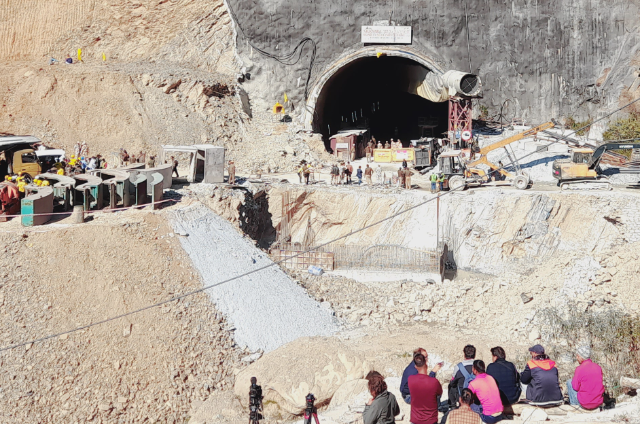Rescuers in India have freed 41 workers who had been trapped in a collapsed Himalayan tunnel for 17 days.
Miners drilled the final section manually to reach the workers in the 4.5km (3-mile) tunnel in Uttarakhand.
Rescued men were immediately taken for check-ups and it was ensured that nobody was left in this process of restoring everything to normalcy. Long and sustained efforts to free them from the Silkyara tunnel which collapsed on 12 November finally did pass all the failed attempts and we are on the other side of the line.
The mission was ultimately completed on Tuesday evening thanks to the efforts of a group of "rat-hole" miners, who used hand-held drills to break through the rock. Various organisations such as the NDMA, Railways, Telecom, Border and Roads Organisation, and many more worked together to get this task completed.
India's president Droupadi Murmu wrote, on Twitter, that she was "relieved and happy" to hear the men had been freed. She also praised the rescue effort, which she said was met with obstacles that had been "a testament of human endurance". A test of human spirit and challenge that ultimately fared well.
The workers were greeted with roaring cheers and flower garlands as they emerged from the tunnel. The Chief Minister of the State felicitated the rescued workers from the tunnel.
Friends, family, and local residents gathered outside the tunnel, setting off firecrackers and distributing sweets. It was a moment where the moments of collective consciousness were seen being reinforced.
Since early in the rescue, those above ground were able to communicate via walkie-talkies with the men, who were supplied with oxygen, food, and water through a separate narrow pipe. It was no less than a Herculean task!
The Silkyara tunnel is part of the 890 km-long flagship Char Dham project connecting key Hindu pilgrim sites via two-lane roads in the Himalayas. This site is highly active to tourist centres.
Since a landslide caused a portion of the tunnel to cave in, teams have tried to clear about 60 metres of rubble - made up of rock and metal - which lay between the men and the tunnel mouth. The aim was to create a horizontal exit passage with crawl-out pipes for the trapped workers.
Having to cut through metal rods in the rubble repeatedly was quite challenging but thanks to the rescue efforts, and later soil gave way to cut through the hard layers. Last Friday, officials said the workers would be out in a matter of hours - until the complete breakdown of the main drilling machine inside the tunnel.
When that happened, two dozen "rat-hole" miners were deployed to manually drill and clear the passage to the trapped workers. Trained in narrow tunnel navigation, they used handheld tools for excavation to clear the last few metres of debris to get to the workers, who came from some of India's poorest states. These workers were largely migrant workers.
The moment the last part of the tunnel broke, it was an outburst of happiness for the labourers and the State people of Uttarakhand. The labourers started clapping for themselves and the government officials asked them to be patient and that they will be moved out of the tunnel one by one.
The Uttarakhand Government has praised both the power of science and God. Millions of people prayed as the rescue operation closeted it's aim.
Environmentalists and residents have blamed that improperly unplanned systems of construction projects have led to the breaking of the landslide and tunnel collapse actually. It's true though that the terrain and the topography of the region are quite rough but the State of Uttarakhand is home to many natural resources and minerals. The mountains do not always possess that built up to sustain huge infrastructure projects.
Rat-hole mining and the hazards of mining have been crucial topics of geographical importance. Green Tribunal Courts declare that the mining activities will be nationalized and will take care of the carbon footprint associated. Simultaneously, it also tries to offer solutions when such problems actually erupt.
. . .
References:
- bbc.com
- deccanherald.com
- indianexpress.com
- timesofindia.indiatimes.com

